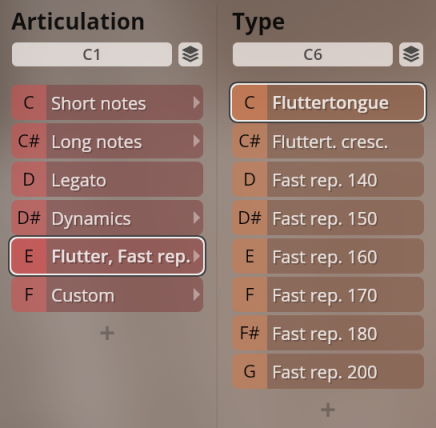SYNCHRON-ized Historic Winds Packs
Introduction
Welcome to the Vienna Symphonic Library's series of Synchron Instruments! SYNCHRON-ized Historic Winds furnishes you with an exquisite collection of historical wind instruments ranging from the Baroque oboe to the ophicleide. This document will provide you with the information you need to use the Library with our Vienna Synchron Player.
About Presets
The library offers three basic Preset types for every instrument in their respective folders "Velocity", marked "VelXF" and "VelXF sus". In the regular "Velocity" presets, note volume is controlled by keystroke velocity just like a piano. In "VelXF" Presets, all articulations have velocity crossfading activated so that you can control dynamics with MIDI controller CC1, the modwheel. In "VelXF sus" Presets, however, velocity crossfading is only activated for long notes, while the dynamics of short notes are controlled by keystroke velocity, thus facilitating phrasing. Velocity crossfading can be enabled or disabled by clicking its on/off symbol in the Synchron Player's Perform tab.
Sound Categories
The Presets of each instrument are subdivided into several Articulation categories (depending on the instrument) plus a "Custom" slot ready for your own creations:
- Short notes
- Long notes
- Legato
- Dynamics
- Flutter tonguing (trumpets and horns only), fast repetitions
Within these Articulation categories, you can select a Type (if applicable), e.g., legato normal or marcato, and for some of the types there are additional options available, such as vibrato type control.
Mixer Presets
For the SYNCHRON-ized Historic Winds instruments, our software developers added a specifically designed convolution reverb derived from Vienna MIR Pro to the Synchron Player, featuring the outstanding and unique ambience of the 540 m2 (5,813 sq.ft.) main hall of Synchron Stage Vienna. The perfectly engineered reverberation and placement presets combine customized impulse responses with expertly crafted reverb settings for each group of the ensemble. By adding the ambience of Synchron Stage Vienna's Stage A to the dry samples in real-time, SYNCHRON-ized Woodwinds perfectly blend with any other product of our Synchron Series.
For each instrument, there are 8 basic Mixer Presets that depict different recording situations: Close, Classic, Wide, Distant, Ambient, Short and Long Reverb without convolution, and MIR Unprocessed for use with Vienna MIR. The crumhorns, trumpets and horns offer right and left side versions of the processed Mixer Presets.
About Patches
Patches can be used to build your own custom Presets and adapt the Synchron Libraries to your specific requirements. For further information on constructing Presets, please see the Synchron Player manual.
About Pitch
For designating pitch, the Vienna Symphonic Library uses International Pitch Notation (IPN), which was agreed upon internationally under the auspices of the Acoustical Society of America. In this system the international standard of A=440 Hz is called A4 and middle C is C4. All pitches are written as capital letters, their respective octave being indicated by a number next to it. The lowest C on the piano is C1 (the A below that is A0), etc.
The Synchron Player software allows you to set middle C to C3, C4, or C5 according to your preference. Selecting another setting than C4 will of course also change the play ranges and keyswitches accordingly.
Synchron Player Presets
The instrument Presets comprise all recorded Patches in Articulation groups, which again contain Types of the respective Articulation, with further options if available. The general structure was modeled after our other Synchron Collections, making it easy to switch or combine instruments without major adaptations.
Articulations are enabled by default and can be disabled individually. Enabling an Articulation means that all the Types contained will be activated, too, so if you happen to be short of RAM it is advisable only to activate what you really need (you can always add more Types later).
By default the keyswitches for Articulations are mapped starting from C1. For the available Types, the keyswitches normally start from C2 for high instruments, and from C6 for lower ones.
Additional options within Articulations or Types are offered by the Dimension Controllers. The controller function is indicated by the respective caption, as of course it may take on different tasks as needed.
Apart from the regular articulations, every instrument also features one called Custom that does not contain any samples. It provides 6 slots ready for you to configure presets of your own.
01 Recorders
Soprano, alto, tenor, and bass recorders.
Range: soprano C5–A7, alto F4–A#6, tenor C4–F6, bass C3–D5
Articulation switches: C1–E1
Type switches: starting at C2
Short notes
Staccato, as well as legato (with and without vibrato) and staccato repetitions.
Legato repetitions: use Dim.Ctrl/B (CC4) to switch between vibrato styles and the vibrato crossfade option, and Dim.Ctrl/C (CC20) to control the crossfade amount.
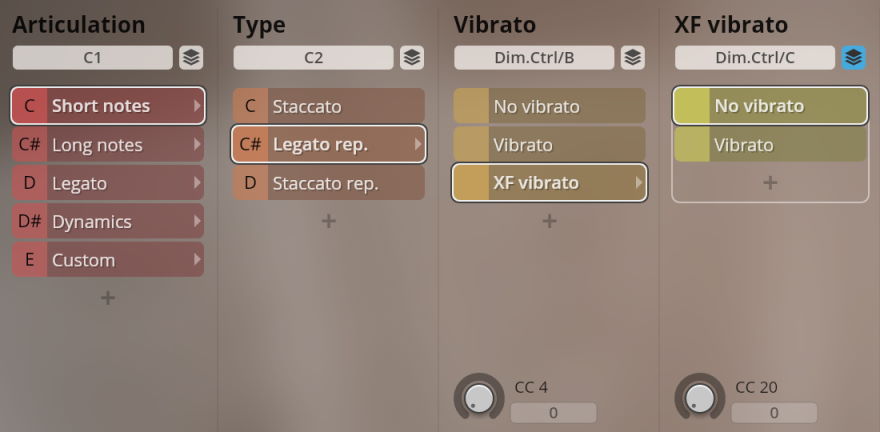
Long notes
Sustained notes with and without vibrato, normal and marcato.
Use Dim.Ctrl/B (CC4) to switch between vibrato styles and the vibrato crossfade option, and Dim.Ctrl/C (CC20) to control the crossfade amount.
If marcato is selected, keystroke velocity on Dim.Ctrl/A determines the marcato amount of the note played.
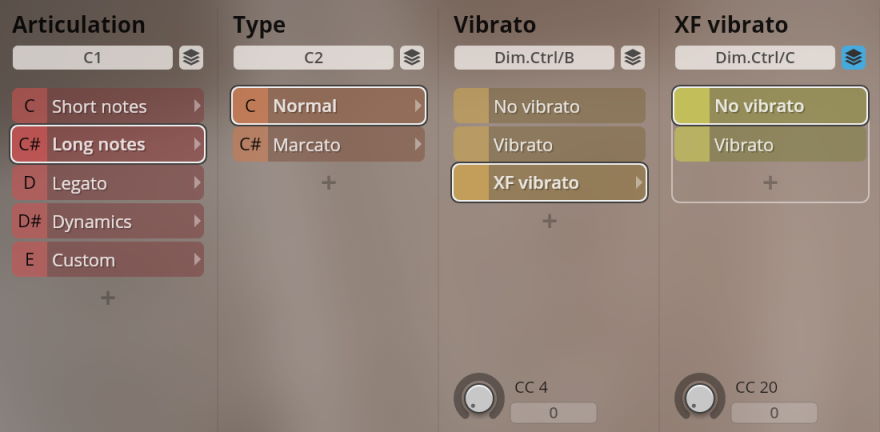
Legato
Performance legato, normal and fast, with and without vibrato.
Use Dim.Ctrl/B (CC4) to switch between vibrato styles and the vibrato crossfade option, and Dim.Ctrl/C (CC20) to control the crossfade amount.
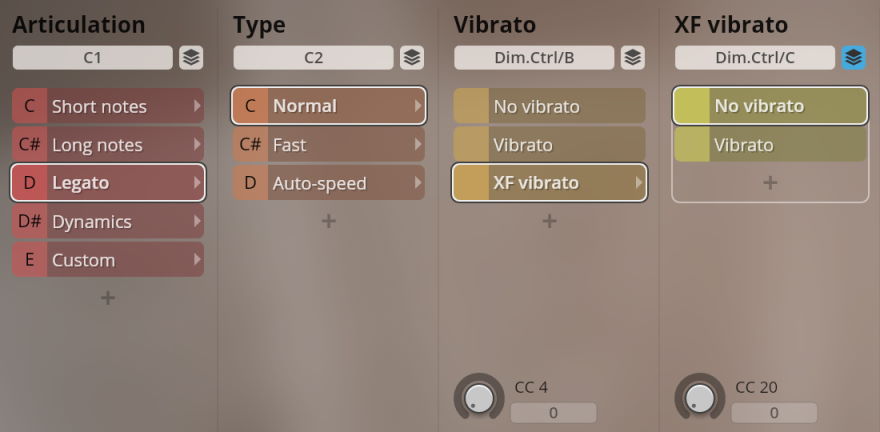
Autospeed
The Auto-speed option implements a speed controller on Dim.Ctrl/D to switch automatically between normal and fast legato.
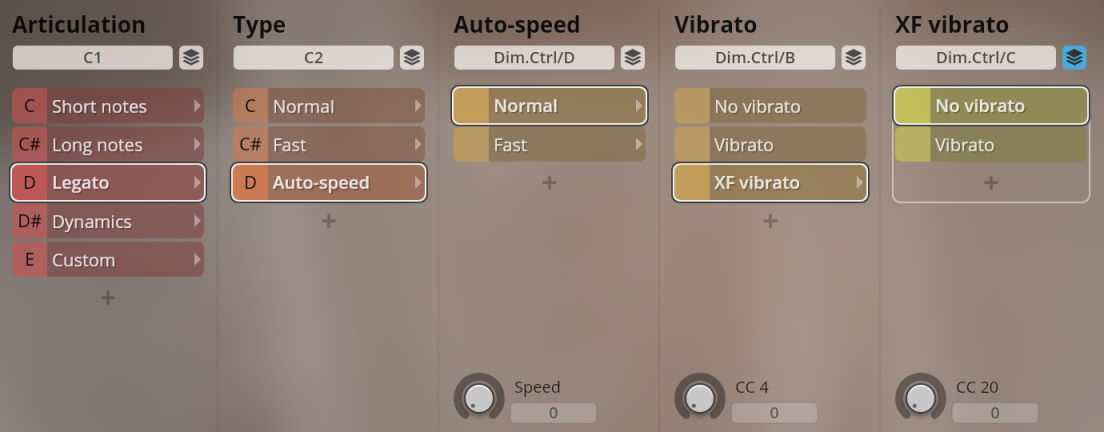
Dynamics
Crescendo and diminuendo 1.5/2/3 sec.
- Cres/dim switches: D#2/E2
- Duration switches: G#2–A#2
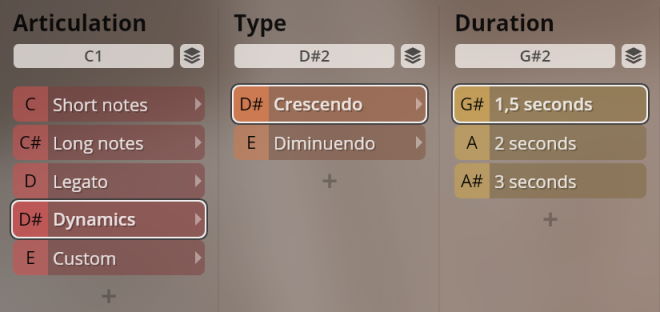
02 Traverso flute
Range: C4–G6
Articulation switches: C1–F1
Type switches: starting at C2
Short notes
Staccato, short and long portato, as well as legato, portato, and staccato repetitions.
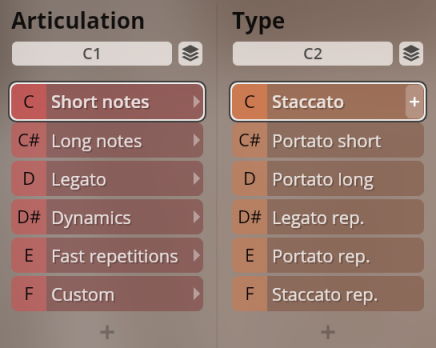
Long notes
Sustained notes, normal and marcato.
If marcato is selected, keystroke velocity on Dim.Ctrl/A determines the marcato amount of the note played.
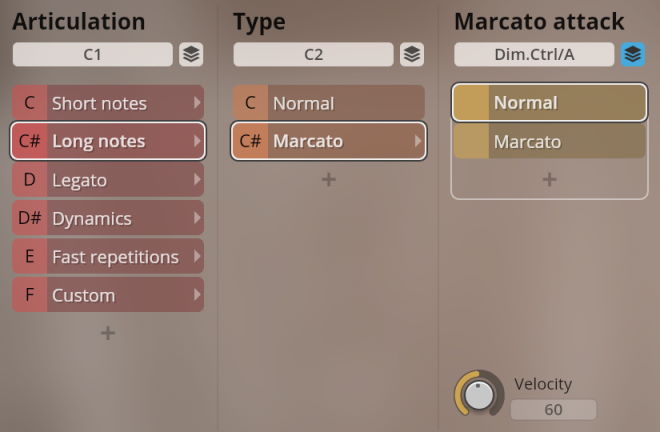
Legato
Performance legato, normal and fast.
The Auto-speed option implements a speed controller on Dim.Ctrl/D to switch automatically between normal and fast legato.
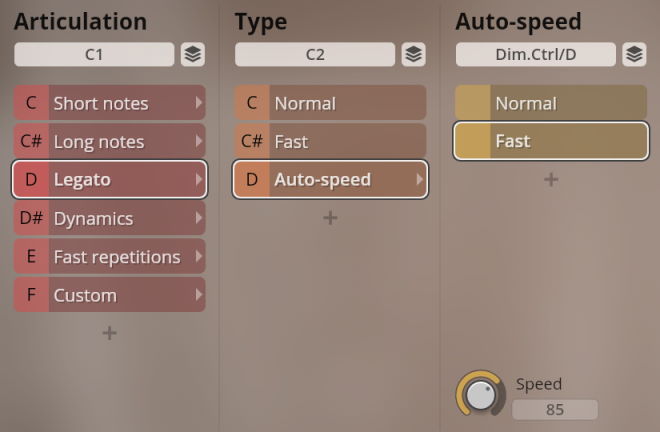
Dynamics
Sforzato, fortepiano, sforzatissimo; crescendo and diminuendo 2/3/4 sec.; and piano-forte-piano, 2/4/6 sec.
- Duration switches: G#2–A#2
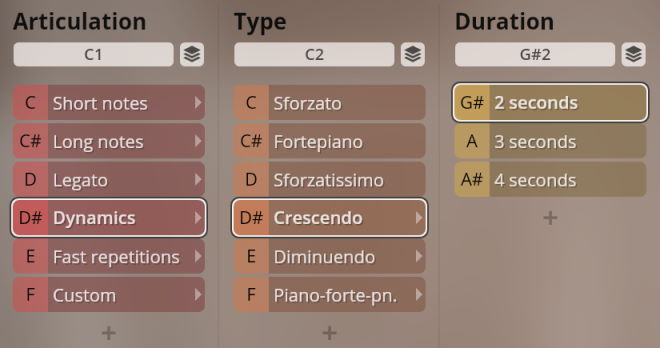
Fast repetitions
Fast repetitions between 140 and 200 BPM.
- Tempo switches: D2–G2
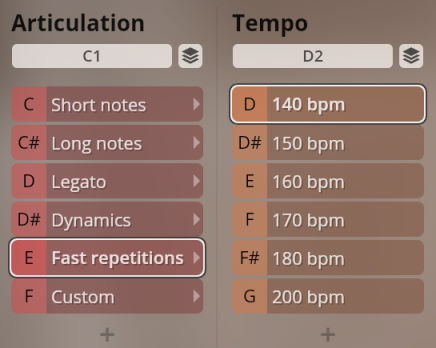
03 Baroque Oboe, 04 Oboe da caccia, 07 Cornett
Range: Baroque oboe C4–D6, oboe da caccia F3–G5, cornett A3–D6
Articulation switches: C1–F1
Type switches: starting at C2
Short notes
Staccato, short and medium portato, as well as legato, portato, and staccato repetitions.
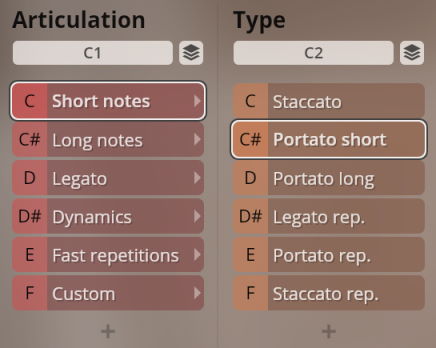
Long notes
Sustained notes, normal and marcato.
If marcato is selected, keystroke velocity on Dim.Ctrl/A determines the marcato amount of the note played.
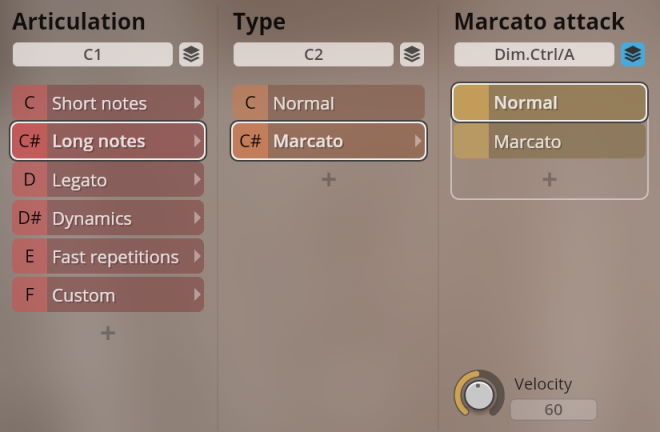
Legato
Performance legato, normal and fast.
The Auto-speed option implements a speed controller on Dim.Ctrl/D to switch automatically between normal and fast legato.
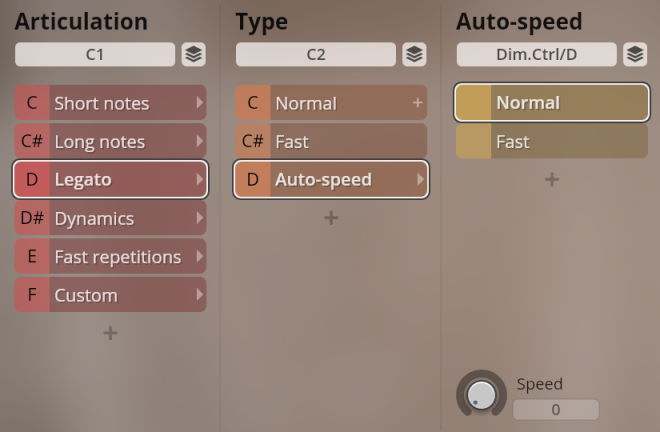
Dynamics
Sforzato, fortepiano, sforzatissimo; crescendo and diminuendo 2/3/4 sec.; piano-forte-piano 2/4/6 sec.
- Duration switches: G#2–A#2
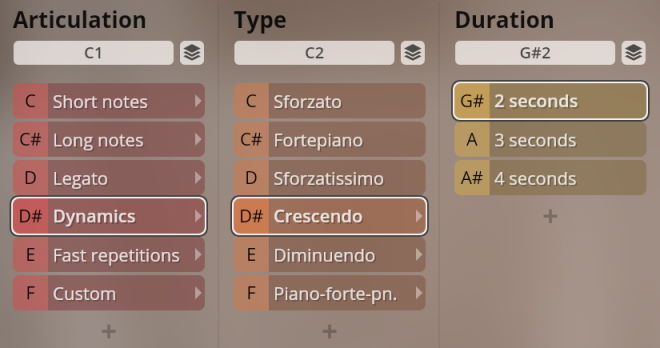
Fast repetitions
Fast repetitions between 140 and 200 BPM.
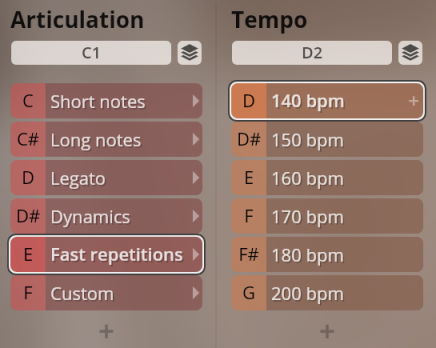
05 Ophicleide
Range: A1–A4
Articulation switches: C1–F1
Type switches: starting at C6
Short notes
Staccato, short and long portato, as well as legato, portato, and staccato repetitions.
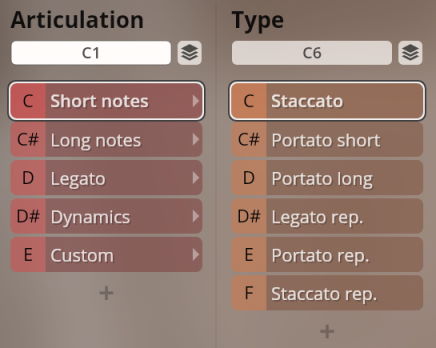
Long notes
Sustained notes, normal and marcato.
If marcato is selected, keystroke velocity on Dim.Ctrl/A determines the marcato amount of the note played.

Legato
Performance legato, normal and fast.
The Auto-speed option implements a speed controller on Dim.Ctrl/D to switch automatically between normal and fast legato.

Dynamics
Sforzato, fortepiano, sforzatissimo; crescendo and diminuendo, 2/3/4 sec.
- Type switches: C6–E6 (white keys only)
- Duration switches: G#2–A#2
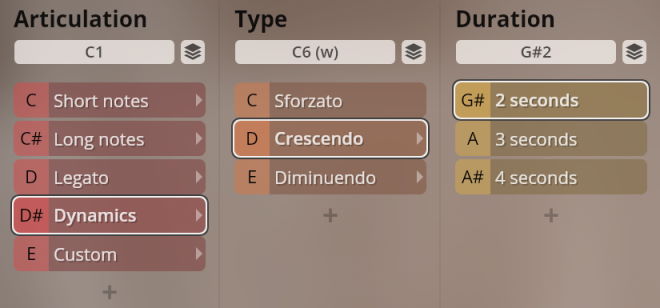
06 Serpent
Range: F1–A4
Articulation switches: C1–E1
Type switches: starting at C6
Short notes
Staccato, short and long portato, as well as legato, portato, and staccato repetitions.
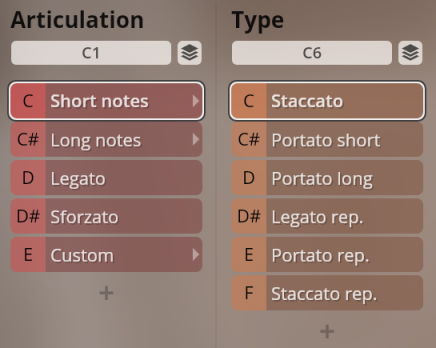
Long notes
Sustained notes, normal and marcato.
If marcato is selected, keystroke velocity on Dim.Ctrl/A determines the marcato amount of the note played.
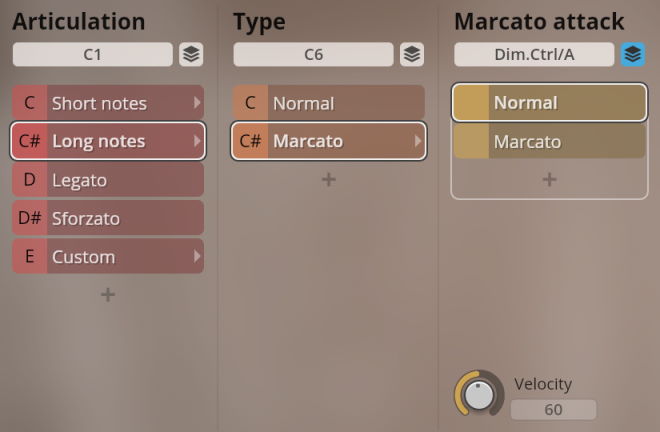
Legato, sforzato
These articulations have no further options.
08 Crumhorns
Soprano, alto, tenor, bass, and great bass crumhorns, and a merged Preset of all five.
Range: soprano C4–F5, alto F3–A#4, tenor C3–F4, bass F2–C4, great bass C2–F3
Articulation switches: C1–E1
Type switches: starting at C2
Short notes
Staccato and short portato, as well as legato, portato, and staccato repetitions.
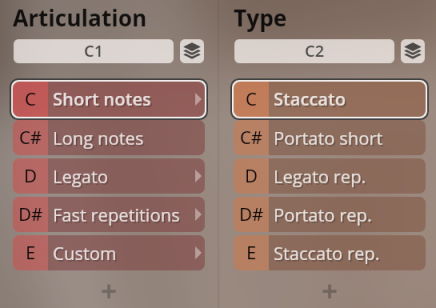
Long notes
Sustained notes, normal.
Legato
Performance legato, normal and fast.
The Auto-speed option implements a speed controller on Dim.Ctrl/D to switch automatically between normal and fast legato.
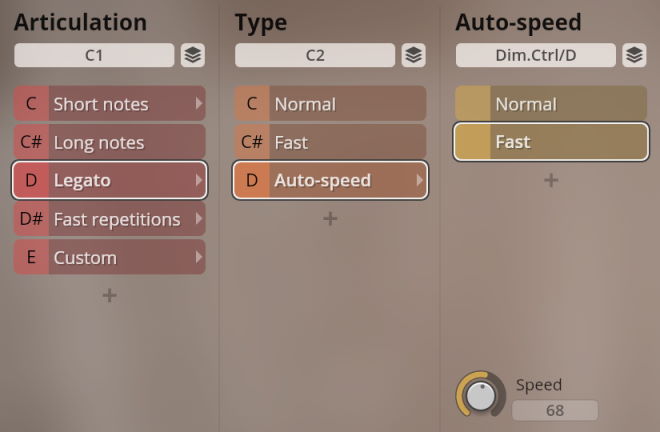
Fast repetitions
Fast repetitions between 140 and 200 BPM.
- Tempo switches: D2–G2
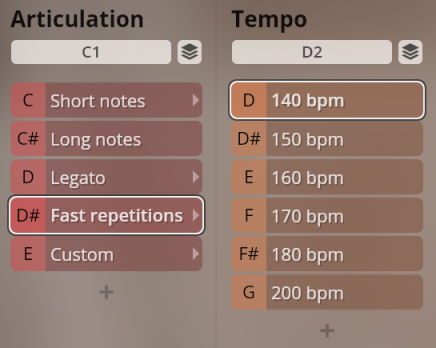
Preset: 06 Crumhorns merged
This Preset combines all 5 crumhorns, substituting legato (as legato between two different instruments is impossible) with a copy of the long notes. The play range is C2–D5.
- Type switches: starting at C6
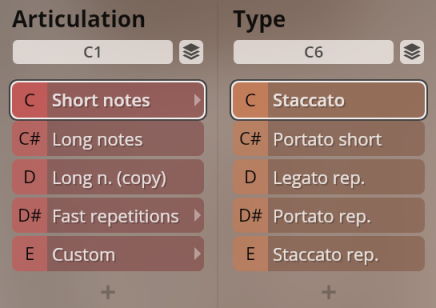
09 Natural Trumpets
Natural trumpets in Bb, C, and D.
Range: Bb trumpet F3, B3, D4–D6; C trumpet G3, C4, E4–D6; D trumpet A3, D4, F#4–E6
Articulation switches: C1–F1
Type switches: starting at C2
Short notes
Staccato and portato, as well as legato, portato, and staccato repetitions.
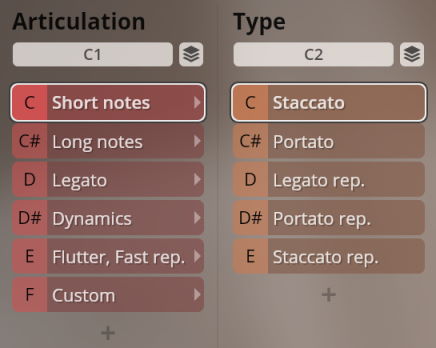
Long notes
Sustained notes with and without vibrato, normal and marcato.
Use Dim.Ctrl/B (CC4) to switch between vibrato styles and the vibrato crossfade option, and Dim.Ctrl/C (CC20) to control the crossfade amount.
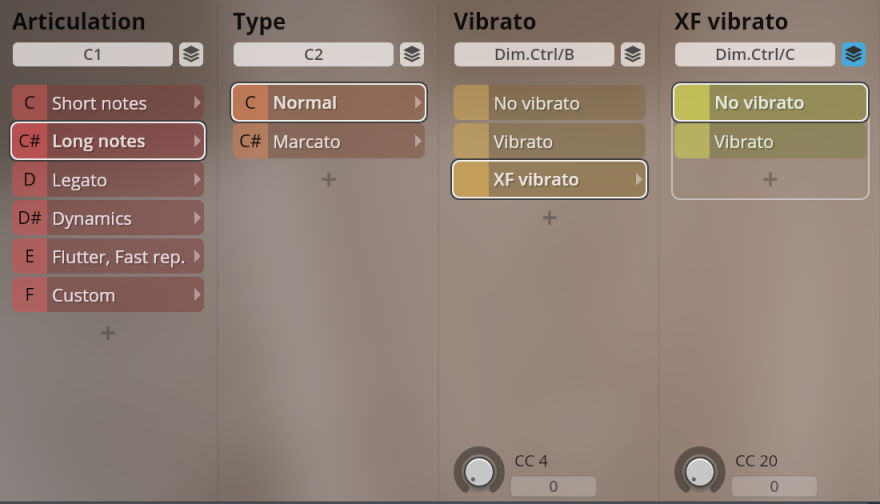
Marcato
If marcato is selected, keystroke velocity on Dim.Ctrl/A determines the marcato amount of the note played.
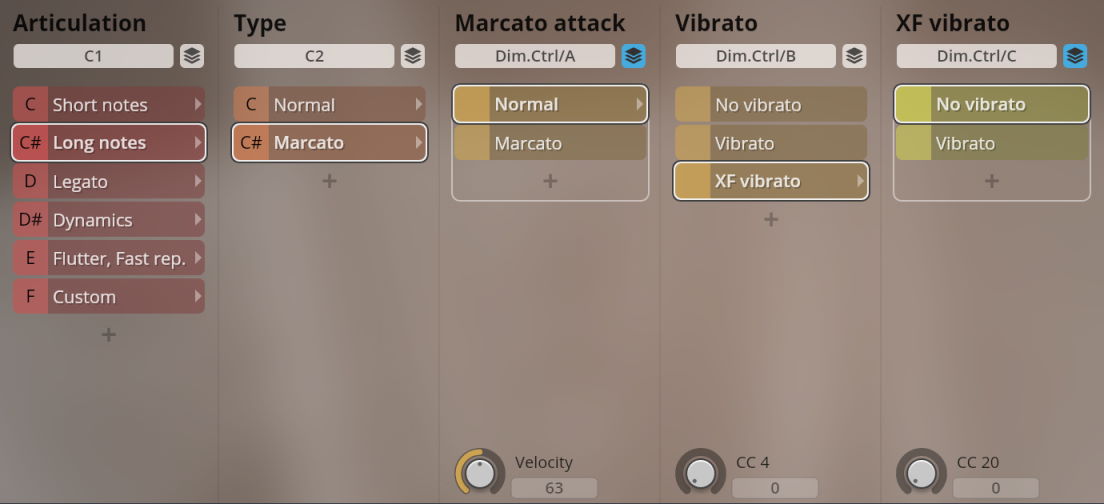
Legato
Performance legato with and without vibrato.
Use Dim.Ctrl/B (CC4) to switch between vibrato styles and the vibrato crossfade option, and Dim.Ctrl/C (CC20) to control the crossfade amount.
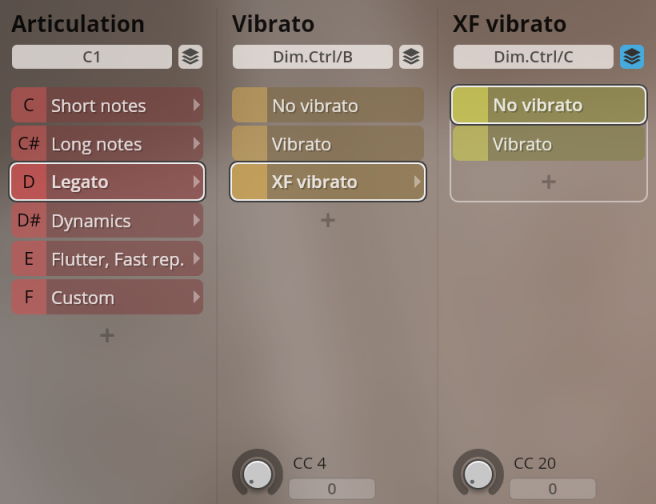
Dynamics
Sforzato, fortepiano, sforzatissimo; crescendo and diminuendo 2/3/4 sec.
- Duration switches: G#2–A#2
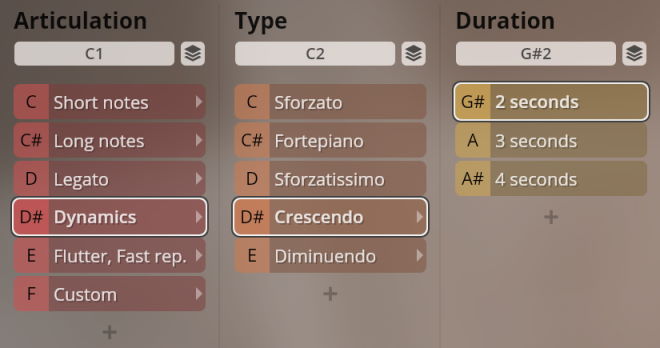
Flutter tongue, fast repetitions
Flutter tonguing, normal and crescendo; fast repetitions between 140 and 200 BPM.
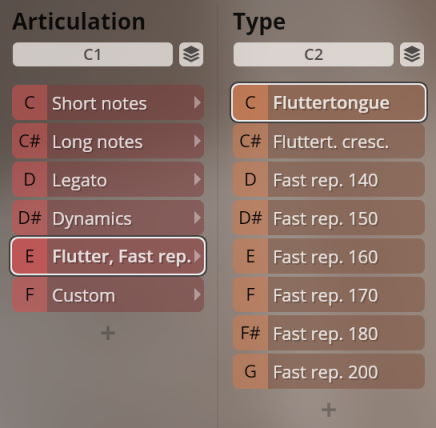
10 Natural Horns
Natural horns: Bb basso, C basso, D, Eb, E, F, G, A, Bb alto, and C alto.
Range: Fundamental, fifth, octave, and chromatic starting from major decime according to instrument tuning, e.g.: Bb basso B1, F2, B2, D3–C5
Articulation switches: C1–F1
Type switches: starting at C6
Short notes
Staccato and portato, as well as legato, portato, and staccato repetitions.
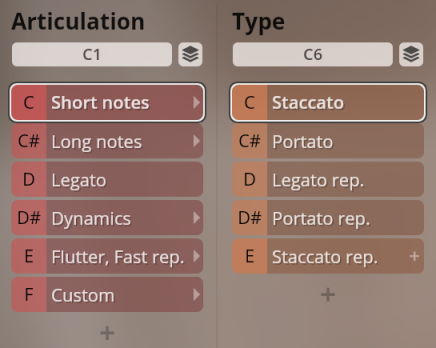
Long notes
Sustained notes, normal and marcato.
If marcato is selected, keystroke velocity on Dim.Ctrl/A determines the marcato amount of the note played.
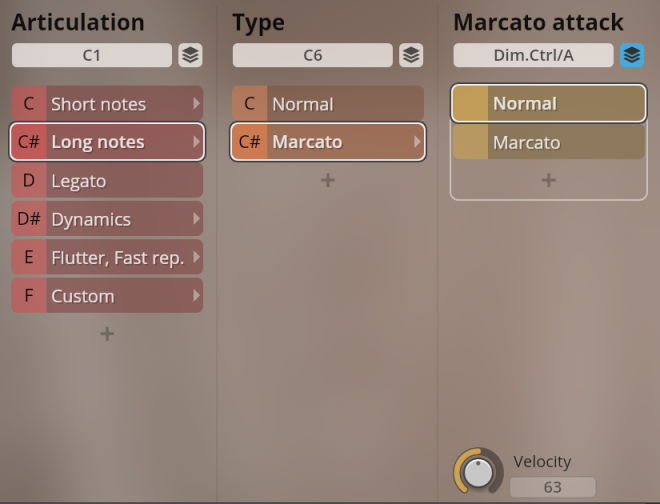
Legato
Legato, normal.
Dynamics
Sforzato, fortepiano, sforzatissimo; crescendo and diminuendo 2/3/4 sec.
- Duration switches: G#2–A#2
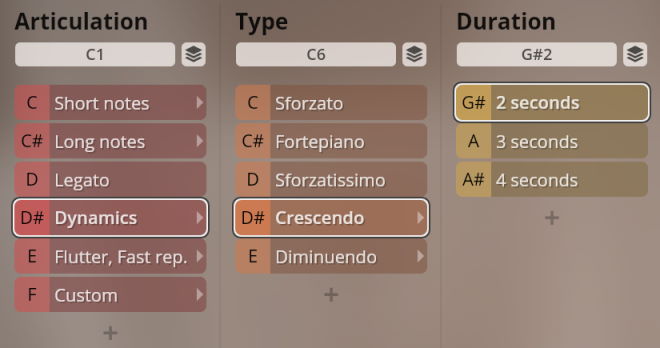
Flutter tongue, fast repetitions
Flutter tonguing, normal and crescendo; fast repetitions between 140 and 200 BPM.
